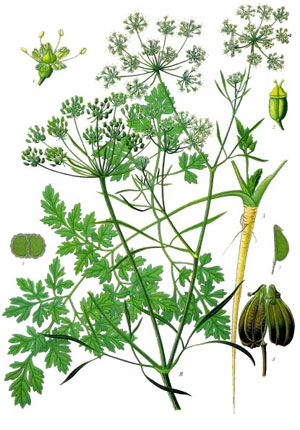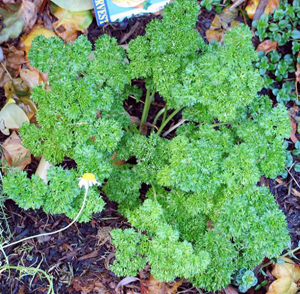Contents:
Common Names | Parts Usually Used | Plant(s) & Culture | Where Found | Medicinal Properties | Biochemical Information
Legends, Myths and Stories | Uses | Formulas or Dosages | Nutrient Content | How Sold | Warning | Resource Links | Bibliography
Scientific Names

- Petroselinum sativum L.
- Umbelliferae
- Umbel family
Common Names
- Common parsley
- Garden parsley
- March
- Parsley breakstone
- Rock parsley
Parts Usually Used
Fruits, berries, stems, leaves, and roots
Back to Top

Description of Plant(s) and Culture
An erect, hairless perennial plant with a distinctive scent. It has shiny, pinnate leaves with triangular-lobed leaflets, often curled in cultivated plants. The small yellowish flowers grow in flat-topped, compound umbels, each with 8-15 smaller umbels. Fruits are egg-shaped, ridged, somewhat flattened.
Other varieties: P. hortense; P. crispum; extra curled dwarf; neapolitanum; gigante; tuberosum; decora.
The Chinese use the herb (Apium petroselinum) (“Inn sai” is the Chinese name) and call it parsley. Seems it is used similarly to Petroselinum sativum L.
Some have categorized parsley as in the carrot family, some in the umbel family and yet others say it has its own parsley family. Let the reader choose or if anyone has proof of which is correct, please forward the information.
Back to Top
Where Found
Cultivated and occasionally found growing wild in waste places or around buildings in eastern and Pacific areas of the United States and Canada. Gathering of wild parsley is not recommended.
Back to Top
Medicinal Properties
Diuretic, carminative, anthelmintic, emmenagogue, expectorant, stimulant, antispasmodic, aperient, laxative, carminative
Juice: febrifuge, promotes menstruation
Back to Top
Biochemical Information
Apiin, apiol, bergaptein, calcium, fatty oil, flavone glycoside, furanocumarin bergapten, iodine, iron, isoimperatorin, mucilage, myristicene, volatile and essential oils, parsley camphor (apiin), petroselinic acid, phosphorus, pinene, potassium, and vitamins A and C.
Back to Top
Legends, Myths and Stories
Some references claim that parsley belongs to the carrot family.
It is claimed, when the parsley herb is rubbed against a glass goblet or tumbler, it will break it. The cause of this phenomenon is unknown.
Rose bushes like for parsley to be grown near them, because they keep away rose beetles.
Parsley is native to the Mediterranean region of Southern Europe and has been cultivated for more than 2,000 years. It was originally used as a medicinal plant (see below) prior to being consumed as a food. Ancient Greeks held parsley to be sacred, using it to not only adorn victors of athletic contests, but also for decorating the tombs of the deceased. While it is uncertain when and where parsley began to be consumed as a seasoning, historians think it may be sometime during the Middle Ages in Europe. Some historians credit Charlemagne with its popularization as he had it grown on his estates.
Back to Top
Uses
Parsley is a sweet plant that contains a substance in which tumor cells cannot multiply. It is good for goiter, obesity, edema, dropsy, swollen glands, epilepsy, bed-wetting, fluid retention, rheumatism, sciatica, lumbago, jaundice, indigestion, asthma, coughs, colds, fever, gas, night blindness, swollen breasts, menstrual disorders, promotes onset of menses, snakebites, bruises, dropsy, eye infections, and worms. For thyroid, lung, stomach, bladder, gall stones, kidney stones, liver, and can be used to treat gravel and stones of the kidney. It also makes a good eyewash. It purifies the breath as well. The oil of parsley rubbed on the scalp is purportedly able to stimulate hair growth.
Back to Top
Formulas or Dosages
A tisane of dried herb is made when fresh is not available.
Eat raw or steep chopped leaves and stems in hot water. Drink 1 cup daily.
Back to Top
Nutrient Content
Calcium, fatty oil, iodine, iron, phosphorus, rich in potassium, and rich in vitamins A and C. Rich in vitamins and minerals. Good source of chlorophyll. (Try it after eating onions or garlic)
Back to Top
How Sold
Parsley tablets or fresh cut herb
Back to Top
Warning
Do not use parsley if a kidney infection is present.
Do not take parsley juice or oil if pregnant, it is a uterine stimulant.
Best grown in the garden rather than gathered wild, since it resembles poisonous wild plants like Poison Hemlock.
Back to Top
Resource Links
LiveStrong.com: Benefits of Juicing Parsley
Natural Health Techniques: Parsley
Bibliography
![]() The Nature Doctor: A Manual of Traditional and Complementary Medicine
The Nature Doctor: A Manual of Traditional and Complementary Medicine, by Dr. H.C.A. Vogel; Keats Publishing, Inc., 27 Pine Street (Box 876) New Canaan, CT. 06840-0876. Copyright Verlag A. Vogel, Teufen (AR) Switzerland 1952, 1991
![]() Back to Eden
Back to Eden, by Jethro Kloss; Back to Eden Publishing Co., Loma Linda, CA 92354, Original copyright 1939, revised edition 1994
![]() Indian Herbalogy of North America
Indian Herbalogy of North America, by Alma R. Hutchens, Shambala Publications, Inc., Horticultural Hall, 300 Massachusetts Avenue, Boston, Massachusetts 02115, 1973
 Earl Mindell’s Herb Bible
Earl Mindell’s Herb Bible, by Earl Mindell, R.Ph., Ph.D., Simon & Schuster/Fireside, Rockefeller Center 1230 Avenue of the Americas, New York, New York 10020
![]() The Herbalist Almanac
The Herbalist Almanac, by Clarence Meyer, Meyerbooks, publisher, PO Box 427, Glenwood, Illinois 60425, copyright 1988, fifth printing, 1994
![]() Culpeper’s Complete Herbal & English Physician: Updated With 117 Modern Herbs
Culpeper’s Complete Herbal & English Physician: Updated With 117 Modern Herbs, by Nicholas Culpeper, Meyerbooks, publisher, PO Box 427, Glenwood, Illinois 60425, 1990, (reprint of 1814)
 Old Ways Rediscovered
Old Ways Rediscovered, by Clarence Meyer, Meyerbooks, publisher, PO Box 427, Glenwood, Illinois 60425, published from 1954, print 1988
Herbal Gardening, compiled by The Robison York State Herb Garden, Cornell Plantations, Matthaei Botanical Gardens of the University of Michigan, University of California Botanical Garden, Berkeley., Pantheon Books, Knopf Publishing Group, New York, 1994, first edition
 The Magic of Herbs
The Magic of Herbs, by David Conway, published by Jonathan Cape, Thirty Bedford Square, London, England. (Out of print)
![]() Planetary Herbology
Planetary Herbology, by Michael Tierra, C.A., N.D., O.M.D., Lotus Press, PO Box 325, Twin Lakes. WI 53181., Copyright 1988, published 1992
![]() American Folk Medicine
American Folk Medicine, by Clarence Meyer, Meyerbooks, publisher, PO Box 427, Glenwood, Illinois 60425, 1973
![]() Prescription for Nutritional Healing, Fifth Edition: A Practical A-to-Z Reference to Drug-Free Remedies Using Vitamins, Minerals, Herbs & Food Supplements
Prescription for Nutritional Healing, Fifth Edition: A Practical A-to-Z Reference to Drug-Free Remedies Using Vitamins, Minerals, Herbs & Food Supplements, by James F. Balch, M.D. and Phyllis A. Balch, C.N.C., Avery Publishing Group, Inc., Garden City Park, NY
![]() Webster’s New World Dictionary
Webster’s New World Dictionary, Third College Edition, Victoria Neufeldt, Editor in Chief, New World Dictionaries: A Division of Simon & Schuster, Inc., 15 Columbus Circle, New York, NY 10023
 An Instant Guide to Medicinal Plants
An Instant Guide to Medicinal Plants, by Pamela Forey and Ruth Lindsay, Crescent Books (January 27, 1992).
 Secrets of the Chinese Herbalists
Secrets of the Chinese Herbalists, by Richard Lucas, Parker Publishing Company, Inc., West Nyack, NY, 1987.
![]() The Yoga of Herbs: An Ayurvedic Guide to Herbal Medicine
The Yoga of Herbs: An Ayurvedic Guide to Herbal Medicine, by Dr. David Frawley & Dr. Vasant Lad, Lotus Press, Twin Lakes, Wisconsin, Second edition, 1988.
 The Rodale Herb Book: How to Use, Grow, and Buy Nature’s Miracle Plants (An Organic gardening and farming book)
The Rodale Herb Book: How to Use, Grow, and Buy Nature’s Miracle Plants (An Organic gardening and farming book), edited by William H. Hylton, Rodale Press, Inc. Emmaus, PA, 18049., 1974
![]() Country Home Book of Herbs
Country Home Book of Herbs, Meredith Books, Editorial Dept. RW240, 1716 Locust Street, Des Moines, IA 50309-3023, copyright 1994
